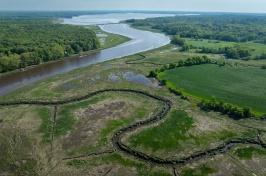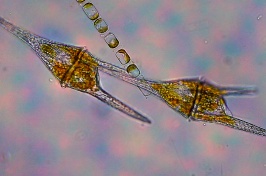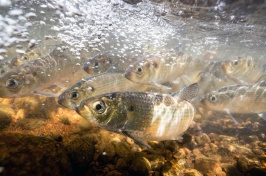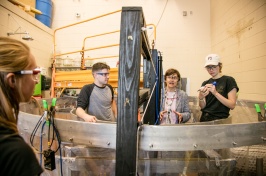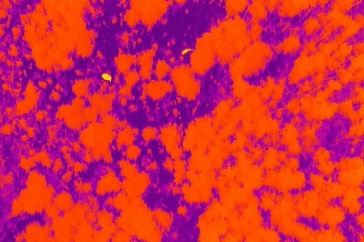
The wasp helped experiment station scientists document 36 species of buprestid beetles, including three new, undocumented species in New Hampshire. Here a wasp has paralyzed a beetle, which is underneath the wasp. Credit: UNH
A predatory wasp has been enlisted in New Hampshire’s fight against the Emerald Ash Borer, a beetle that has been spreading across the United States killing ash trees for more than two decades. New research funded by the New Hampshire Agricultural Experiment Station at the University of New Hampshire indicates that the Smokey Winged Beetle Bandit may be much more effective in monitoring the spread of the Emerald Ash Borer in the Granite State than standard traps.
The Smokey Winged Beetle Bandit, or Cerceris fumipennis, preys on all buprestid beetles, including the Emerald Ash Borer. It has been found to outperform the purple prism traps in detecting presence of the beetle. Researchers hypothesize that the wasp can work as an effective monitoring system for the Emerald Ash Borer, alerting state officials to new beetle infestations. The wasp may be particularly useful in detecting beetles when they are few in number, thereby helping manage populations and reducing the overal costs associated with this pest.
“A number of Emerald Ash Borer colonies have been recently located in New Hampshire, with two surveillance techniques being used: killing ash trees to attract beetles and using purple prism traps. This research focuses on a third technique – monitoring the buprestid beetles caught and killed by the wasp,” said entomologist Donald Chandler, a UNH zoology professor and experiment station researcher who oversaw the project.

The primary goal of this research is to develop greater precision in determining the foraging distance of the Smokey Winged Beetle Bandit. In addition, researchers want to develop baseline information on colony activity, seasonality, and prey preferences of the wasp in different forest types for New Hampshire, according to Chandler.
Chandler collaborated with Morgan Dube, a graduate student in biological sciences and entomologist with the NH Department of Agriculture, Markets, and Food. She conducted the research project for her master’s thesis. “This was a great topic for a research project. I was able to help out the NH Division of Forests and Lands and the NH Department of Agriculture, Markets, and Food, both agencies that currently use Cerceris fumipennis for bio-surveillance of Agrilus planipennis, the Emerald Ash Borer,” Dube said.
“Although it is unlikely we will stop this pest, we now have more efficient and practical methods of detecting this pest than ever before, including Cerceris fumipennis, a charismatic and incredible wasp that has the ability to find, sting, and paralyze the Emerald Ash Borer. There is much still to learn about Cerceris fumipennis, but they have proven themselves a worthy ally in the hunt for the buprestid beetle family, of which the Emerald Ash Borer is a member,” Dube said.
Experiment station scientists investigated the wasp at two locations in the Concord area, a primarily deciduous area in Epsom and a primarily coniferous area in Boscawen. Both are near a known Emerald Ash Borer site in Concord. Specifically, the researchers looked at the seasonality of the wasps, their prey preferences, times of activity, amount of time spent searching and productivity, and the percent of paralyzation of the beetle prey.
The wasp helped experiment station scientists document 36 species of buprestid beetles, including three new, undocumented species in New Hampshire. While the two sample sites were in proximity to a known Emerald Ash Borer site in Concord, this beetle has not yet been detected in the immediate area of the two wasp colonies. UNH scientists found no Emerald Ash Borer beetles among the more than 800 specimens collected, which provided information on the host range of the wasp.
“The wasps have proven to be much more effective in monitoring buprestid beetle populations than any of the sticky traps used in New Hampshire at this time. No Emerald Ash Borer beetles were detected at our sites, which indicates that it has not reached these areas since other research studies have shown the wasp is very effective in detecting the beetle’s presence,” Chandler said. “The range of the Emerald Ash Borer beetle is expanding each year in New Hampshire so it is very important that we have an effective monitoring system to track it across the state.”
According to Dube, three New Hampshire counties are under quarantine due to positive Emerald Ash Borer detections: Merrimack, Rockingham, and Hillsborough counties. This means all ash articles and all hardwood firewood within this area are regulated and cannot leave the area without treatment and certification. Although ash trees make up between 4 and 7 percent of New Hampshire forests, she said the cost could be great for land owners and municipalities.
“As the excitement over this pest recedes once many of our ash trees have died, there are many lessons to learn. The threat of invasive species will never go away. Public awareness is extremely important. The movement of firewood is thought to be the major pathway for the spread of these pests. To help fight the Emerald Ash Borer, residents should buy local wood and burn local. Leave your wood at home, buy it where you burn it and burn it all where you buy it,” Dube said.
The 36 species of buprestid beetles collected, including the three new species, were placed in the UNH Insect Collection, which is the largest insect collection in the state with more than 600,000 specimens.
Founded in 1887, the NH Agricultural Experiment Station at theUNH College of Life Sciences and Agriculture is UNH’s original research center and an elemental component of New Hampshire's land-grant university heritage and mission. We steward federal and state funding, including support from the USDA National Institute of Food and Agriculture, to provide unbiased and objective research concerning diverse aspects of sustainable agriculture and foods, aquaculture, forest management, and related wildlife, natural resources and rural community topics. We maintain the Woodman and Kingman agronomy and horticultural farms, the Macfarlane Greenhouses, the Fairchild Dairy Teaching and Research Center, and the Organic Dairy Research Farm. Additional properties also provide forage, forests and woodlands in direct support to research, teaching, and outreach.
-
Written By:
Lori Tyler Gula, PhD | NH Agricultural Experiment Station | lori.gula@unh.edu | 603-862-1452


























